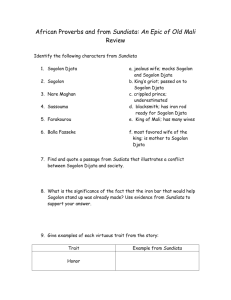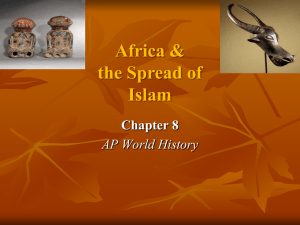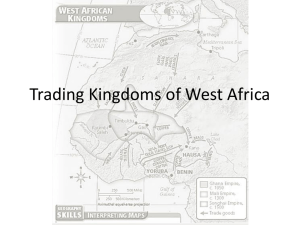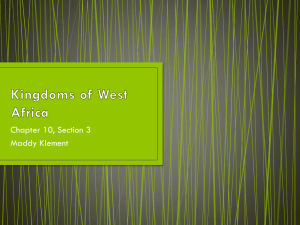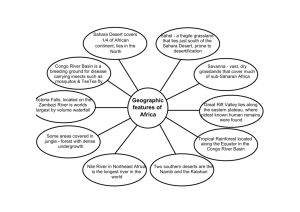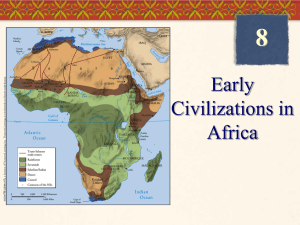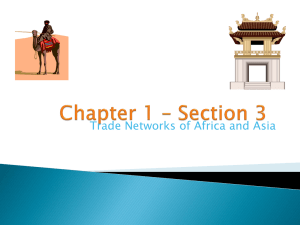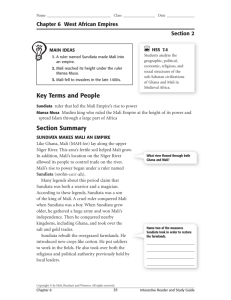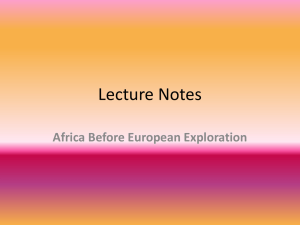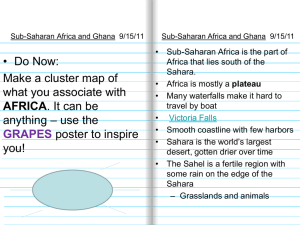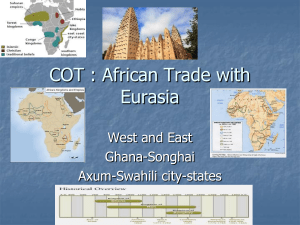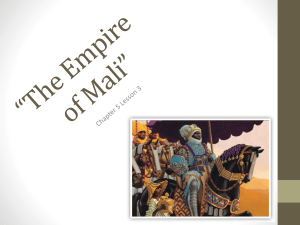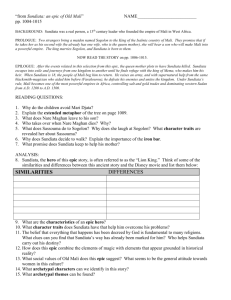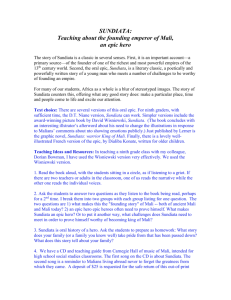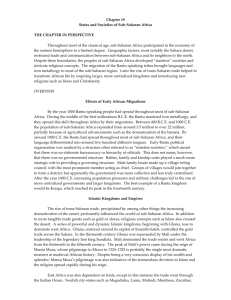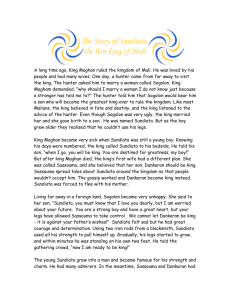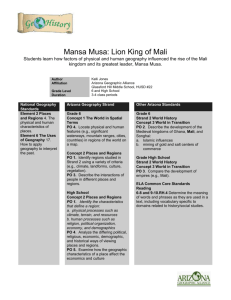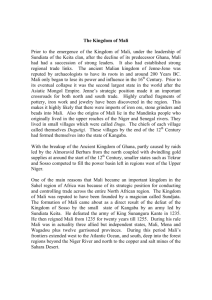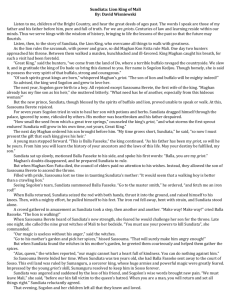Chapter 19: Africa What was the function of the griot in sub
advertisement
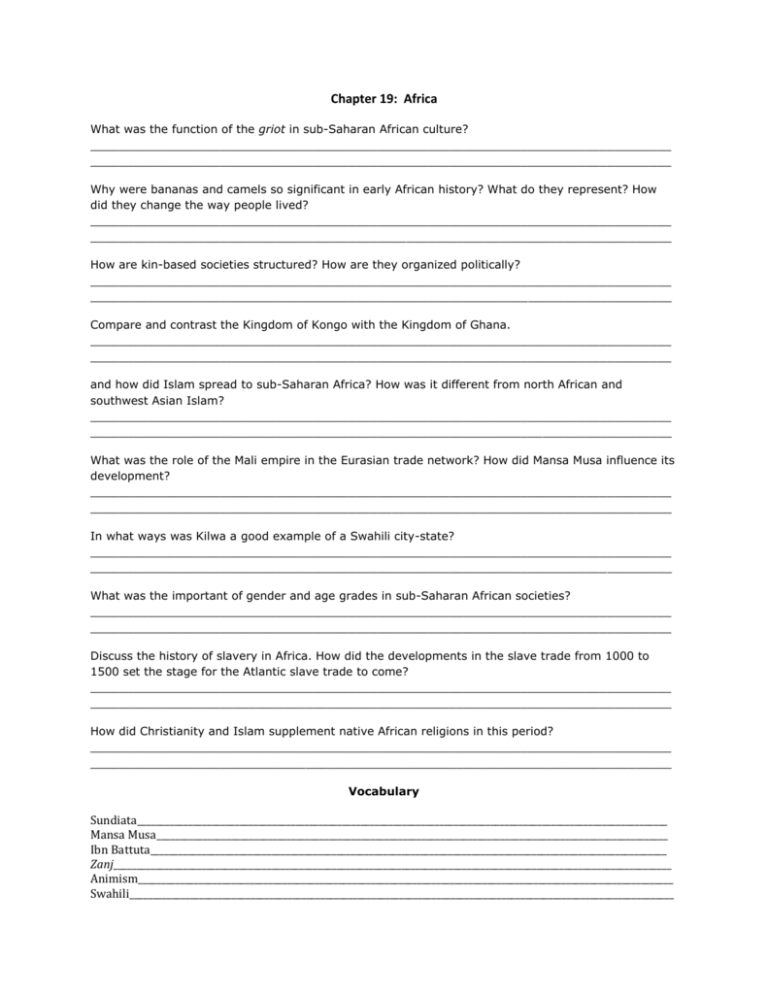
Chapter 19: Africa What was the function of the griot in sub-Saharan African culture? _________________________________________________________________________________ _________________________________________________________________________________ Why were bananas and camels so significant in early African history? What do they represent? How did they change the way people lived? _________________________________________________________________________________ _________________________________________________________________________________ How are kin-based societies structured? How are they organized politically? _________________________________________________________________________________ _________________________________________________________________________________ Compare and contrast the Kingdom of Kongo with the Kingdom of Ghana. _________________________________________________________________________________ _________________________________________________________________________________ and how did Islam spread to sub-Saharan Africa? How was it different from north African and southwest Asian Islam? _________________________________________________________________________________ _________________________________________________________________________________ What was the role of the Mali empire in the Eurasian trade network? How did Mansa Musa influence its development? _________________________________________________________________________________ _________________________________________________________________________________ In what ways was Kilwa a good example of a Swahili city-state? _________________________________________________________________________________ _________________________________________________________________________________ What was the important of gender and age grades in sub-Saharan African societies? _________________________________________________________________________________ _________________________________________________________________________________ Discuss the history of slavery in Africa. How did the developments in the slave trade from 1000 to 1500 set the stage for the Atlantic slave trade to come? _________________________________________________________________________________ _________________________________________________________________________________ How did Christianity and Islam supplement native African religions in this period? _________________________________________________________________________________ _________________________________________________________________________________ Vocabulary Sundiata__________________________________________________________________________________________________________________ Mansa Musa______________________________________________________________________________________________________________ Ibn Battuta_______________________________________________________________________________________________________________ Zanj________________________________________________________________________________________________________________________ Animism___________________________________________________________________________________________________________________ Swahili_____________________________________________________________________________________________________________________ Sundiata____________________________________________________________________________________________________________________ Mansa Musa________________________________________________________________________________________________________________ Axum_______________________________________________________________________________________________________________________ 1. Mali became the wealthiest kingdom in sub-Saharan Africa because of a. its technological leadership. b. its alliance with Spain. c. its control of the gold trade. d. its control of the spice trade. e. its domination of the oasis towns. 2. The introduction of a new food crop about 400 C.E. encouraged a fresh migratory surge in Africa. What was the crop? a. bananas b. wheat c. beans d. potatoes e. corn 3. By 1000, most parts of Africa south of the equator had been settled by people speaking what language? a. Mali b. Swahili c. Kongo d. Indo-European e. Bantu 4. In relation to spreading their language across a huge stretch of Africa, the Bantu played a role similar to that played by the a. Indo-Europeans. b. Mongols. c. Visigoths. d. Xiongnu. e. Franks. 5. By the middle of the first millennium B.C.E., the Bantu had begun to produce a. bronze. b. iron. c. copper. d. tin. e. steel. 6. In regard to political structure, the early Bantu societies a. governed themselves mostly through family and kinship groups. b. depended on a strong, centralized kingship. c. developed an elaborate hierarchy of officials. d. were influenced by their trading contacts with Rome. e. were governed by a centralized, theocratic structure. 7. The most tightly centralized of the fourteenth-century Bantu kingdoms was a. Kongo. b. Axum. c. Swahili. d. Songhay. e. Kush. 8. One of the central factors in the establishment of trans-Saharan trade was a. the invention of lighter, but still powerful, artillery. b. the use of large caravans of donkeys. c. the spread of a common religion. d. the invention of a wider horseshoe. e. the domestication of the camel. 9. The most powerful state in west Africa at the time of the arrival of Islam was a. Swahili. b. Ghana. c. Axum. d. Kongo. e. Kush. 10. The legendary founder of the kingdom of Mali was a. Great Zimbabwe. b. Niani. c. Sundiata. d. Mansa Musa. e. Al-Bakri. 11. Mali would reach its peak during the reign of a. Sundiata. b. Ibn Battuta. c. Al-Bakri. d. Mansa Musa. e. Chaghatai. 12. Which one of the following factors was not one of the foundations of Mali’s power? a. control over trans-Saharan trade b. a vibrant religious inspiration caused by the king’s conversion to Christianity c. a strong cavalry d. a series of powerful kings e. use of Arabian scholars and bureaucrats 13. Who made a famous pilgrimage to Mecca in 1324–1325? a. Mansa Musa b. Koumbi-Saleh c. Sundiata d. Ibn Battuta e. Zanj 14. The Swahili city-states a. succeeded in uniting Africa for the first time. b. strongly maintained their Christian roots. c. dominated trade along the east African coast. d. became the dominant political force in west Africa after the collapse of the Mali kingdom. e. spread Islam throughout Africa. 15. The most powerful kingdom in central Africa was a. Kush. b. Mogadishu. c. Zimbabwe. d. Ghana. e. Mali. 16. The term zimbabwe originally referred to a. the dwelling of a chief. b. the animistic spirit of nature. c. a cavalry force. d. the principal crop of east and central Africa. e. a lion, which was considered sacred. 17. Just as the kingdoms of west Africa depended on trans-Saharan trade, the kingdoms of east Africa depended on a. Egyptian trade. b. Indian Ocean trade. c. trans-Atlantic trade. d. south African trade. e. Persian Gulf trade. 18. Ibn Battuta a. was a Moroccan jurist who traveled throughout Africa. b. founded the Mali Empire. c. was an Islamic merchant who converted many Africans. d. wrote the Sundiata. e. was the powerful Islamic official who dominated trade in the Indian Ocean 19. In regard to gender issues in sub-Saharan Africa, a. the position of women was essentially the same as in other societies of the time. b. women played the dominant role in society. c. women played a strictly subservient role. d. women had more opportunities open to them than did their counterparts in other societies. e. women had no opportunities and suffered more than their counterparts elsewhere. 20. In sub-Saharan Africa, an age grade was a. a publicly recognized group that performed tasks based on their strength and maturity. b. a ceremony marking the passage from childhood to adulthood. c. the ritual suicide of tribal members, who were too old to contribute to the tribe. d. one aspect of the elaborate educational system. e. the infanticide of female babies. 21. Since there was no concept of private ownership of land in sub-Saharan Africa, a. all members of the tribe lived in complete social equality. b. slave ownership formed an important aspect of determining personal wealth. c. social differentiation was based entirely on physical strength and military prowess. d. all land was owned by the chief. e. the land was owned by the church. 22. Ali bin Muhammad a. founded the kingdom of Zimbabwe. b. traveled widely throughout Africa and recorded his observances. c. was the author of the Sundiata. d. led the zanj revolt. e. converted Mansa Musa to Islam. 23. Axum was a. a Christian kingdom in Ethiopia. b. the founder of the Ghana state. c. the capital of the Swahili city-states. d. the great creator god of most sub-Saharan religions. e. a Swahili slave. 24. Ethiopian Christianity a. was identical to Roman Catholicism. b. was influenced much more profoundly by the Greek Orthodox Church. c. retained both traditional African and Christian beliefs. d. was much closer to certain Islamic beliefs than to Roman Catholicism. e. was almost entirely African in nature. 25. Christian churches, carved from solid rock, are an example of the influence of a. trade connections with India. b. pre-Christian values. c. contacts with Greek Orthodox missionaries. d. Muslim conquest. e. Neolithic architectural design.


